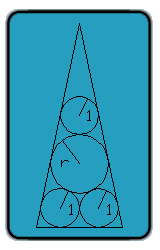Let's place this on a Cartesian graph, sitting on the x-axis, and centered on the y-axis.
R is the radius of the big (middle circle).
Let's introduce point A as the center of the top circle, point B as the center of the big (middle) circle, point C as the point of tangency between the two bottom circles, and point D as the center of the right, bottom circle.
Point C sits at (0,1)
since it is on the y-axis, and is at the same height (y value) as the center of the two lower circles
Point D is at (1,1)
since it is at the center of the the right, bottom circle
Draw right triangle BCD. The length of BD (the hypotenuse) is R+1. The length of CD is 1. Let the length of CB = x.
x² + 1² = (R+1)²
x = √(R² + 2R)
Therefore, point B sits at (0, 1 + √(R² + 2R) )
Point A is R + 1 (the sum of the two radii) higher than point B, therefore it is at (0, R + 2 + √(R² + 2R) ).
And of course, the length of AC is therefore R + 1 + √(R² + 2R).
Let's introduce point E, the point of tangency of the middle circle and the right side of the triangle.
Introduce line segment AD which connects the centers of two 1 unit circles. This line segment is parallel to the side of the right triangle (both circles have radius 1).
Introduce line segment BE which is perpendicular to the line segment AD and to the side of the triangle. Call the intersection of BE and AD, point F.
Note that length of BE = R, FE = 1, and BF = R-1.
Draw triangle ABF and DBF. Note that these two are similar right triangles (having hypotenuse = R+1, one leg = R-1, and therefore, the other leg must be 2√R).
Therefore, the length of AD = 2 * 2√R = 4√R.
This is the hypotenuse of right triangle ACD.
AC = has already been determined above: R + 1 + √(R² + 2R)
and CD = 1
So, let's set up the pythagorean theorem and solve for R:
( 4√R. )² = ( R + 1 + √(R² + 2R) )² + (1)²
This can be simplified to:
2R² - 12R + (2R+2)(√(R²+2R)) + 2 = 0
If we solve this, numerically for R, we get
R is approximately equal to 1.51067547264602
I probably made an error along the way, please check my work.
Edited on October 20, 2003, 6:24 pm




